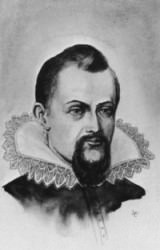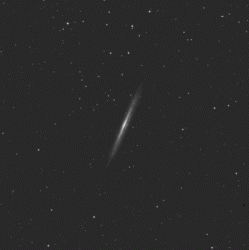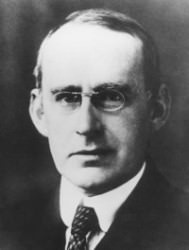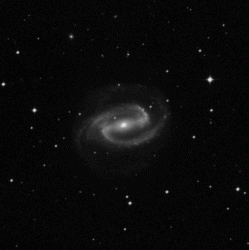Greetings, fellow SkyWatchers! I trust everyone had a pleasant holiday? If you received new binoculars, a telescope or an eyepiece as a present – then why don’t we put them to a workout with some great new targets to have a look at? Why stop at just one galactic star cluster when you can catch three-in-one! It’s a great time for the galaxy hunt, too… So let’s step out in the dark together, cuz’ here’s what’s up!
Friday, December 26, 2008 – Sir William Herschel stop exploring because of the holidays? Never! I’m even beginning to believe the master also never had a Moon or a cloudy night. So what was he into on this night in 1785? Let’s find out… Beginning with binoculars a little less than a fist width northeast of Aldebaran for a triple treat: two clusters within a cluster. Their designations are NGC 1746, 1758, and 1750.
Located near the galactic anti-center in the direction of the Taurus dark clouds (RA 05 03 48 Dec +23 46 00), Dreyer was the first besides Herschel to believe this trio were physically overlapping star clusters. Studied photometrically, the neighboring Pleiades and Hyades clearly show as foreground objects while our “questionable clusters” appear reddened to different degrees. Of course, like many disputed regions, the larger, sparser, NGC 1746 may not be considered a cluster by some books – even though the two interior collections of stars show marked distance differences.
No matter how you view it, enjoy this large collection for yourself. NGC 1746 shows as a widely scattered field with two areas of compression to binoculars, while even a small telescope will resolve southern NGC 1750 (a Herschel “400” object) with its prominent double star. The smaller collection – NGC 1758 – will be just to its northeast. Until the proper motion of this trio is properly studied by proper equipment, you can still consider it another good call on Herschel’s part, and a real triple treat!
 Saturday, December 27, 2008 – Born today in 1571 was Johannes Kepler – a Danish astronomer and assistant to Tycho Brahe. Kepler used Brahe’s copious notes of Mars’ positions to help formulate his three laws of planetary motion. These laws are still applicable today. If you’re up before dawn this morning, you can see them in action as Mars has returned low on the eastern horizon!
Saturday, December 27, 2008 – Born today in 1571 was Johannes Kepler – a Danish astronomer and assistant to Tycho Brahe. Kepler used Brahe’s copious notes of Mars’ positions to help formulate his three laws of planetary motion. These laws are still applicable today. If you’re up before dawn this morning, you can see them in action as Mars has returned low on the eastern horizon!
Tonight is New Moon and there is a vast array of things we could choose to look at. I am a galaxy hunter at heart, and nothing makes it beat just a little bit quicker than an edge-on. Tonight let’s walk into the lair of the Dragon as we seek out the incredible NGC 5907.
 Located just a few degrees south of Iota Draconis (RA 15 15 53 Dec +56 19 43), this particular galaxy is worth staying up just a bit late to catch. Located about 40 million light-years away, 10th magnitude NGC 5907 contains far more than meets the casual eye. It’s warped. Long believed to have been the prototype for non-interacting galaxies, things changed drastically when two companion dwarf galaxies were discovered. A faint, photographic ring structure revealed itself, exposing tidal disruption – the ellipsoid involving the nuclear region of the primary galaxy pulling apart the small spheroid. Also part of the picture is PGC 54419, another dwarf so close to the warp as to almost belong to NGC 5907 itself!
Located just a few degrees south of Iota Draconis (RA 15 15 53 Dec +56 19 43), this particular galaxy is worth staying up just a bit late to catch. Located about 40 million light-years away, 10th magnitude NGC 5907 contains far more than meets the casual eye. It’s warped. Long believed to have been the prototype for non-interacting galaxies, things changed drastically when two companion dwarf galaxies were discovered. A faint, photographic ring structure revealed itself, exposing tidal disruption – the ellipsoid involving the nuclear region of the primary galaxy pulling apart the small spheroid. Also part of the picture is PGC 54419, another dwarf so close to the warp as to almost belong to NGC 5907 itself!
In smaller scopes, prepare yourself to see nothing more than an averted vision scratch of light. The larger the aperture, the more there is revealed, as 5907 gains a bright and prominent nucleus. Although it doesn’t look like the grand spiral we envision our own Milky Way to be, we are looking at it from a different angle. In this respect, it behaves much like our own microcosm – a living, interacting, member of a larger group, and of a much, much larger Universe.
 Sunday, December 28, 2008 – Today we celebrate the birth of Arthur S. Eddington. Born in 1882, Eddington was a British theoretical astrophysicist whose work was fundamental to interpreting and explaining stellar nature. He also coined the phrase “expanding universe” to refer to the mutual recession of the galaxies. This idea would eventually become known as “Hubble’s Law,” as the massive 200″ telescope at Palomar Observatory played another important role when Eddington’s work in this field was continued by Edwin Hubble. Tonight let us honor both great minds as we take a look at a galaxy which is indeed receding from us – NGC 1300.
Sunday, December 28, 2008 – Today we celebrate the birth of Arthur S. Eddington. Born in 1882, Eddington was a British theoretical astrophysicist whose work was fundamental to interpreting and explaining stellar nature. He also coined the phrase “expanding universe” to refer to the mutual recession of the galaxies. This idea would eventually become known as “Hubble’s Law,” as the massive 200″ telescope at Palomar Observatory played another important role when Eddington’s work in this field was continued by Edwin Hubble. Tonight let us honor both great minds as we take a look at a galaxy which is indeed receding from us – NGC 1300.
Located about a finger width north of Tau 4 Eridani (RA 03 19 41 Dec 19 24 40), this is probably the most incredible barred spiral you will ever encounter. At magnitude 10, it will require at least a 4.5″ telescope in northern latitudes, but can probably be spotted with binoculars in the far south.
 75 million light-years away, NGC 1300’s central bar alone is larger than the Milky Way, and this galaxy has been intensively studied because the manner of its formation was so similar to our own. Although it is so distant, it is seen face-on: allowing us to see this formation without looking through the gas and dust which block our own Galaxy’s center from view. Enjoy this one’s fantastic structure!
75 million light-years away, NGC 1300’s central bar alone is larger than the Milky Way, and this galaxy has been intensively studied because the manner of its formation was so similar to our own. Although it is so distant, it is seen face-on: allowing us to see this formation without looking through the gas and dust which block our own Galaxy’s center from view. Enjoy this one’s fantastic structure!
Until next week, remember… Dreams really do come true when you keep on reaching for the stars!
This week’s awesome photos are: 60 arc minute view centered on NGC 1746 – Credit: Palomar Observatory, courtesy of Caltech, Johannes Kepler (widely used public image), NGC 5907 – Credit: Palomar Observatory, courtesy of Caltech, Arthur Eddington – Credit: American Institute of Physics Niels Bohr Library and NGC 1300 – Credit: Palomar Observatory, courtesy of Caltech. We thank you so much!



This is so much help for my homework!!!
im trying to find out what the big bright star in the southwest sky , next to the moon is. do you know or where can i find it? i observed it last sat evening while driving home and see it again tonight. no one knows what it is or where to find out. can you help?
yeah, sweetie…. it’s venus. 😉
Tyge Brahe was Danish, yes, but I’m pretty sure Kepler was German.